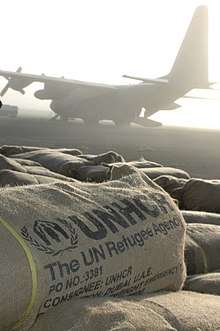Cao ủy Liên Hợp Quốc về người tị nạn
| Cao ủy Liên Hợp Quốc về người tị nạn | |
|---|---|
| United Nations High Commissioner for Refugees | |
| Tên gọi tắt | UNHCR |
| Lãnh đạo | Filippo Grandi |
| Thành lập | 14 tháng 12 năm 1950 |
| Trang web | UNHCR.org |
| Trực thuộc | ECOSOC |
| Genève, | |
Cao ủy Liên Hợp Quốc về người tị nạn (tiếng Anh: United Nations High Commissioner for Refugees, viết tắt UNHCR), hay Cao uỷ Tị nạn Liên Hợp Quốc, thường gọi tắt là "Cao ủy Tị nạn", được thành lập ngày 14 tháng 12 năm 1950 và có trụ sở tại Genève (Thụy Sĩ).[1]

Tiền thân của tổ chức này là Tổ chức quốc tế về người tị nạn (International Refugee Organization), và trước nữa là Cơ quan Liên Hợp Quốc về Cứu tế và Phục hồi (United Nations Relief and Rehabilitation Administration).
Mục đích của Cao ủy là chỉ huy và phối hợp các hoạt động quốc tế nhằm bảo vệ người tị nạn và giải quyết các vấn đề về tị nạn trên toàn thế giới.
Cao ủy đã được tặng Giải Nobel Hòa bình hai lần: 1954 và 1981.
Danh sách các Cao ủy trưởng
[sửa | sửa mã nguồn]Các Cao ủy viên[2]
| Tt | Cao ủy | Từ nước | Thời gian |
|---|---|---|---|
| 11 | Filippo Grandi | 2016– Hiện nay | |
| 10 | António Guterres | 2005–2015 | |
| - | Wendy Chamberlin | tháng 2-6/2005, Tạm thời | |
| 9 | Ruud Lubbers | 2001–2005, Từ chức vì điều tra nội bộ | |
| 8 | Mrs. Sadako Ogata | 1990–2000 | |
| 7 | Thorvald Stoltenberg | tháng 1–11/1990 | |
| 6 | Jean-Pierre Hocké | 1986–1989 | |
| 5 | Poul Hartling | 1978–1985 | |
| 4 | Sadruddin Aga Khan | 1965–1977 | |
| 3 | Félix Schnyder | 1960–1965 | |
| 2 | Auguste R. Lindt | 1956–1960 | |
| 1 | Gerrit Jan van Heuven Goedhart | 1951–1956 | |
| x | Fridtjof Nansen | 1922-1927, Cao ủy Hội Quốc Liên |
Trước khi thành lập của UNHCR, từ năm 1922, Fridtjof Nansen là Cao ủy Liên minh các Quốc gia của Văn phòng quốc tế Nansen về người tị nạn (Nansen International Office for Refugees).
Xem thêm
[sửa | sửa mã nguồn]Tham khảo
[sửa | sửa mã nguồn]- ^ Die Organisationsstruktur von UNHCR Lưu trữ 2015-05-16 tại Wayback Machine. Truy cập 15/05/2015.
- ^ UNHCR Ehemalige FlüchtlingshochkommissarInnen. Lưu trữ 2015-05-29 tại Wayback Machine Retrieved 15/05/2015.
Liên kết ngoài
[sửa | sửa mã nguồn]| Wikimedia Commons có thêm hình ảnh và phương tiện truyền tải về Cao ủy Liên Hợp Quốc về người tị nạn. |
- Trang chính của Cao ủy
- Thông tin cơ bản Lưu trữ 2021-01-26 tại Wayback Machine từ website chính thức
- Văn phòng Cao ủy Liên Hợp Quốc về người tị nạn tại Việt Nam (tiếng Anh)
| Hệ thống Liên Hợp Quốc |
| |||||||||
|---|---|---|---|---|---|---|---|---|---|---|
| Thành viên và Quan sát viên | ||||||||||
| Lịch sử |
| |||||||||
| Nghị quyết |
| |||||||||
| Bầu cử |
| |||||||||
| Các chủ đề liên quan |
| |||||||||
| Khác |
| |||||||||
| ||||||||||
Text is available under the CC BY-SA 4.0 license; additional terms may apply.
Images, videos and audio are available under their respective licenses.

